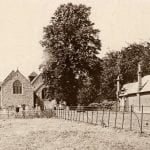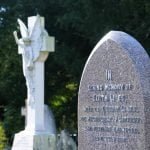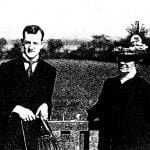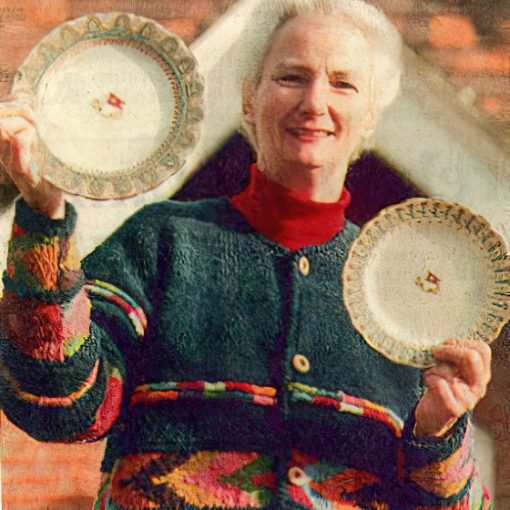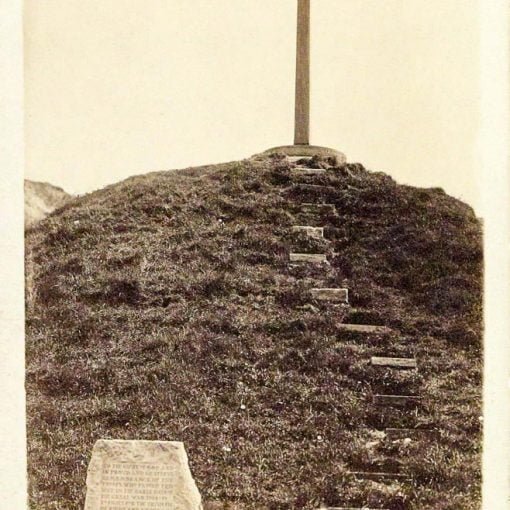What’s the connection between this postcard, the first World War, a grave in Compton churchyard, and a romance with the master of a 19th century convict ship? Read on…
- Compton School as it looked after the church was extended in 1905. This was the postcard which helped Alex Conolly trace her great-grandmother’s grave.
- Gravestone of Edith Lines in Compton churchyard
- Edith Lines and son Keith
In late October 2007, a query came in via the Parish Council website from a lady in Australia, Alex Conolly, who was trying to trace her great grandmother’s grave, starting from a scribbled note on the back of the old postcard which is reproduced above. This is what she wrote:
My great grandmother, Mrs Edith Lines, was buried in the cemetery of Compton Church. She died in or about 1916, having spent time nursing WWI soldiers in Britain. She was an Australian citizen and the wife of the then General Manager of the Bank of New South Wales (now known as Westpac Banking Corporation). Edith was buried by her son, Keith Lines (also an Australian citizen) who served in the British Army and later fought in the Third Battle of Ypres.
The reason for my correspondence is that my mother, Heather Conolly, grand-daughter of Edith Lines would dearly love to have a picture of her grandmother’s headstone or some documentary evidence to prove that Edith Lines was buried in the cemetery of Compton Church. The only document we have in our possession is a postcard (circa 1916) of the Church with a handwritten note of my grandfather, Keith Lines, indicating that “my mother’s grave is in this church yard”.
Luckily, Edith’s gravestone was easy to find, very well preserved. The lettering is clear but says very little about Edith. It was a sunny day and the grass in the churchyard had recently been strimmed, so I was able to send them some photos, including the one above. Alex wrote back:
I cannot properly express how thrilled both my mother and I are to have received your email and those photographs of Edith’s grave. My mother told me last night that she felt sad for her grandmother that she was buried alone, the rest of her family buried together in Sydney.
However, when she saw your photographs last night she was reassured at how lovely and well looked after her grandmother’s grave is and that she is buried in such a beautiful churchyard.
Romance at sea
Edith Lines was born in Australia in 1857, the fifth of seven children of Kezia Elizabeth (née Hayter) and Captain Charles Ferguson.
Scottish born Captain Ferguson was master of the Rajah, a three-masted barque built at Whitby, which sailed between Leith and Australia. On one of those journeys, he met Kezia Hayter who had been sent out to Australia by prison reformer, Elizabeth Fry, to look after the female convicts on board.
They married and eventually settled in Melbourne where, in 1852, Captain Charles Ferguson became the state of Victoria’s first Chief Harbour Master. After a long and honourable career in the Government Service of Victoria he died, and was buried in London while on a visit to Great Britain. Edith’s elder brother George had joined the Williamstown Volunteer Rifles as a 15 year old gunner and worked his way up to Colonel and acting Commandant of the South Australian forces.
The family of Edith’s husband Oscar Lines came from Hertfordshire. He was born in Adelaide in 1861. At 16 he joined the Bank of New South Wales where he gained rapid promotion, eventually being appointed General Manager of the bank in August 1921. Oscar died in 1943, never having remarried.
The Great War
Oscar and Edith’s son Keith (seen in the photo with his mother in about 1914) served in France as a lieutenant in the Royal Field Artillery. He was wounded in March 1918 and had recovered ready to return to France when hostilities ended.
Their daughter, up to within a few weeks of the outbreak of war, had been studying as a violinist in Germany, and finally in Prague, under the renowned Sevjek, the most celebrated teacher in Europe.
Edith, who had come to England to nurse soldiers, had died in 1916 in Shawford of meningitis contracted while nursing the sick and injured. As she had come from the other side of the world to contribute to the war effort, and died so far from home, it seemed only fitting, without belittling the sacrifice of those who had fallen in combat, to include her name when we read out the Roll of Honour at the Wayside Cross on Remembrance Sunday, 11 November 2007.
AW
with acknowledgements to Alex Conolly and to the Ferguson family website
Reprinted, with minor amendments, from the January 2008 Parish Magazine

